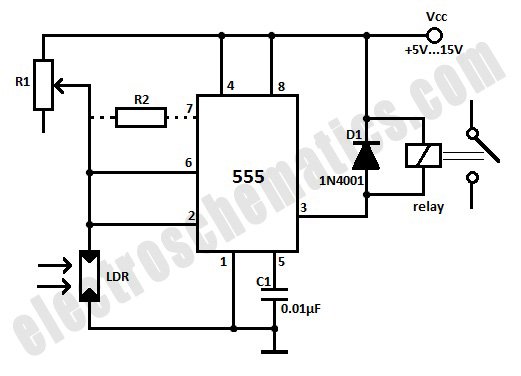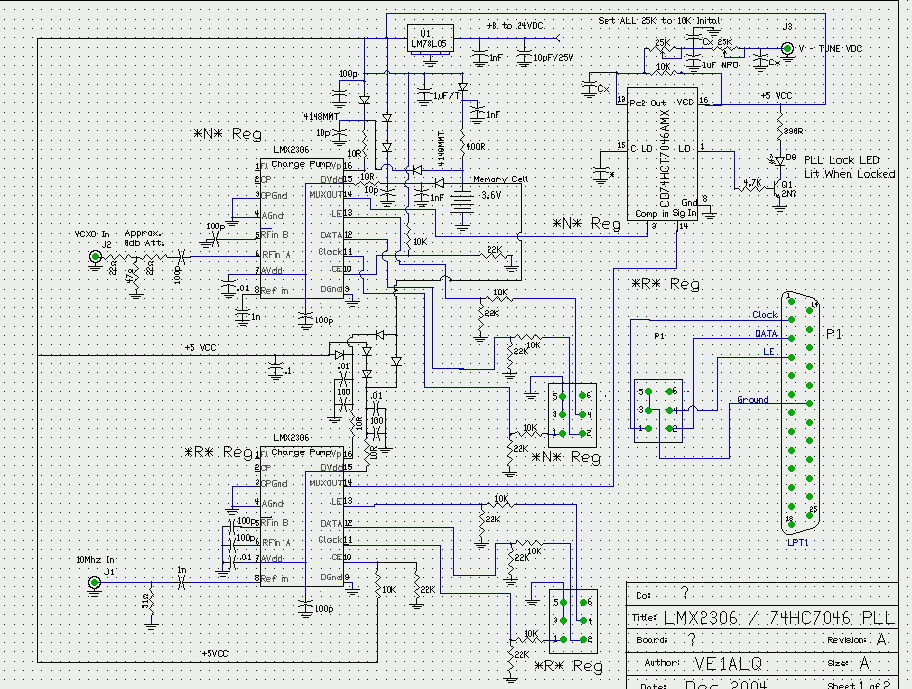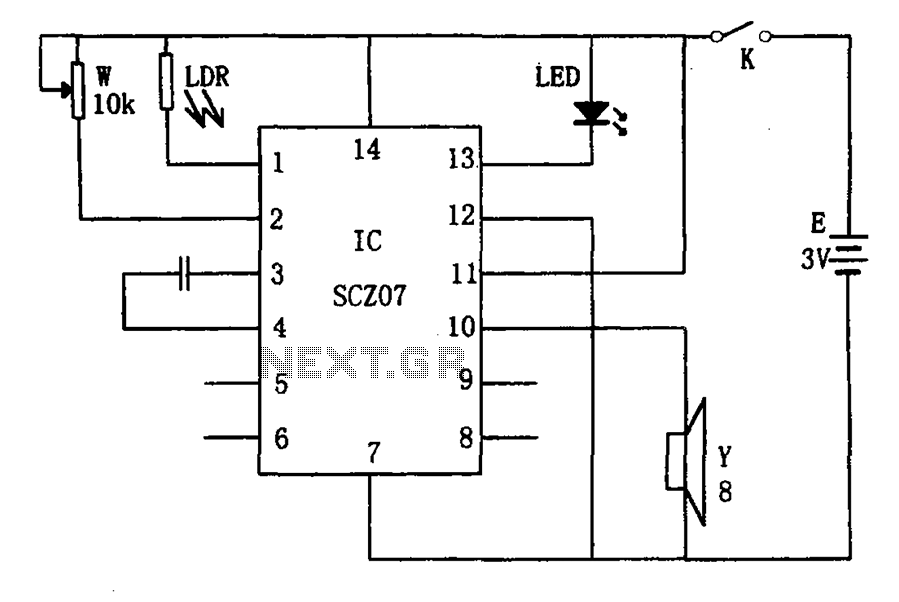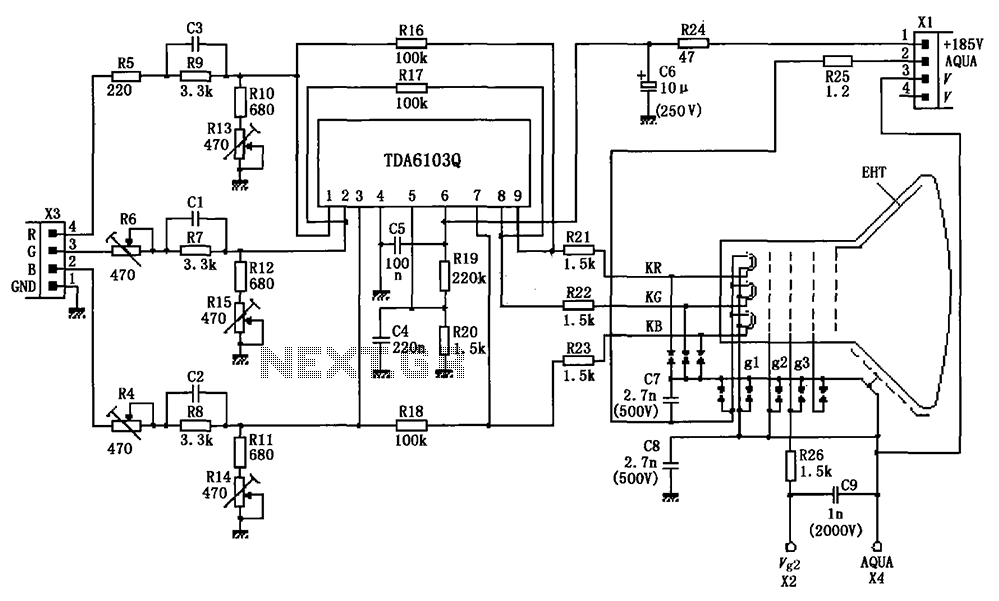
Light Activated Relay with 555 Circuit

This light-activated relay circuit utilizes the 555 timer integrated circuit (IC) and a light-dependent resistor (LDR) to create a light-sensitive relay suitable for applications such as intruder alarm systems or automatic lamp control at sunset and sunrise. The potentiometer R1 must be selected and adjusted so that, under normal lighting conditions, the voltage across the LDR is less than one-third of the supply voltage (Vcc). At this point, the output of the 555 IC remains high. The specific value of R1 is contingent upon the resistance of the LDR. When light intensity decreases or is obstructed by an intruder, the voltage across the LDR increases above two-thirds of Vcc, triggering the flip-flop within the IC. Consequently, the output transitions to a low state, activating the relay. Once the light is restored, the voltage drops below one-third of Vcc, once again triggering the flip-flop, which causes the output to return to a high state, deactivating the relay. The voltage differential of one-third of Vcc between the activation and deactivation points prevents relay chatter. This differential can be further minimized by incorporating a resistor R2, represented as a dotted line in the schematic, with a value approximately one and a half times that of the LDR's resistance in illuminated conditions. A relay rated for 6V or 12V with a maximum current of 200mA should be employed.
The light-activated relay circuit operates on the principle of comparing the voltage levels at the threshold pins of the 555 timer. The circuit is designed with two reference voltage levels: one at 1/3 Vcc and the other at 2/3 Vcc. The LDR serves as a variable resistor whose resistance decreases with increasing light intensity, allowing for precise control over the relay operation. The inclusion of the potentiometer R1 allows fine-tuning of the circuit's sensitivity to light changes, ensuring reliable performance in varying ambient light conditions.
In operation, when the ambient light level drops, the resistance of the LDR increases, causing the voltage at the threshold pin to rise. Once this voltage exceeds 2/3 Vcc, the output of the 555 timer switches from high to low, energizing the relay coil. This action can be used to trigger an alarm or turn on a light, depending on the application. Conversely, when the light level increases, the LDR's resistance decreases, and the voltage at the threshold pin drops below 1/3 Vcc, returning the output to a high state and deactivating the relay.
The addition of resistor R2 is a crucial design aspect that enhances stability by adjusting the hysteresis of the circuit. This resistor ensures that the relay does not rapidly switch on and off due to minor fluctuations in light levels, which could cause unwanted activation or deactivation. Careful selection of R1 and R2 values, along with the appropriate relay specifications, will ensure the circuit functions effectively in its intended application. The circuit can be powered using a suitable DC power supply that matches the relay's voltage rating, ensuring safe and reliable operation.This light activated relay circuit presented here uses the 555 timer IC and a light dependent resistor or LDR to form a light sensitive relay in an intruder alarm system or for switching on a lamp at Sun set and off at Sun rise. Potentiometer R1 value must be chosen and then adjusted that under normal conditions when the light is falling on the LD
R the voltage across the LDR is less than 1/3 of Vcc. The output of the 555 IC is high now. The actual value of R1 will depend on the resistance of the LDR. When the light fades or is interrupted by an intruder, the voltage across it rises above 2/3 of Vcc, tripping the IC flip-flop. The output goes low activating the relay. When the light is restored, voltage falls below 1/3 of Vcc, again tripping the flip-flop causing the output to go high and the relay drops.
The difference of 1/3 of Vcc between turning on and turning off voltages prevents relay chatter. This differential can be reduced by connecting a resistor R2 shown dotted in the schematic. Its value is about one and a half times of the LDR resistance in its illuminated condition. Use a 6V or 12V relay with a current of 200mA max. 🔗 External reference
The light-activated relay circuit operates on the principle of comparing the voltage levels at the threshold pins of the 555 timer. The circuit is designed with two reference voltage levels: one at 1/3 Vcc and the other at 2/3 Vcc. The LDR serves as a variable resistor whose resistance decreases with increasing light intensity, allowing for precise control over the relay operation. The inclusion of the potentiometer R1 allows fine-tuning of the circuit's sensitivity to light changes, ensuring reliable performance in varying ambient light conditions.
In operation, when the ambient light level drops, the resistance of the LDR increases, causing the voltage at the threshold pin to rise. Once this voltage exceeds 2/3 Vcc, the output of the 555 timer switches from high to low, energizing the relay coil. This action can be used to trigger an alarm or turn on a light, depending on the application. Conversely, when the light level increases, the LDR's resistance decreases, and the voltage at the threshold pin drops below 1/3 Vcc, returning the output to a high state and deactivating the relay.
The addition of resistor R2 is a crucial design aspect that enhances stability by adjusting the hysteresis of the circuit. This resistor ensures that the relay does not rapidly switch on and off due to minor fluctuations in light levels, which could cause unwanted activation or deactivation. Careful selection of R1 and R2 values, along with the appropriate relay specifications, will ensure the circuit functions effectively in its intended application. The circuit can be powered using a suitable DC power supply that matches the relay's voltage rating, ensuring safe and reliable operation.This light activated relay circuit presented here uses the 555 timer IC and a light dependent resistor or LDR to form a light sensitive relay in an intruder alarm system or for switching on a lamp at Sun set and off at Sun rise. Potentiometer R1 value must be chosen and then adjusted that under normal conditions when the light is falling on the LD
R the voltage across the LDR is less than 1/3 of Vcc. The output of the 555 IC is high now. The actual value of R1 will depend on the resistance of the LDR. When the light fades or is interrupted by an intruder, the voltage across it rises above 2/3 of Vcc, tripping the IC flip-flop. The output goes low activating the relay. When the light is restored, voltage falls below 1/3 of Vcc, again tripping the flip-flop causing the output to go high and the relay drops.
The difference of 1/3 of Vcc between turning on and turning off voltages prevents relay chatter. This differential can be reduced by connecting a resistor R2 shown dotted in the schematic. Its value is about one and a half times of the LDR resistance in its illuminated condition. Use a 6V or 12V relay with a current of 200mA max. 🔗 External reference
Warning: include(partials/cookie-banner.php): Failed to open stream: Permission denied in /var/www/html/nextgr/view-circuit.php on line 713
Warning: include(): Failed opening 'partials/cookie-banner.php' for inclusion (include_path='.:/usr/share/php') in /var/www/html/nextgr/view-circuit.php on line 713





